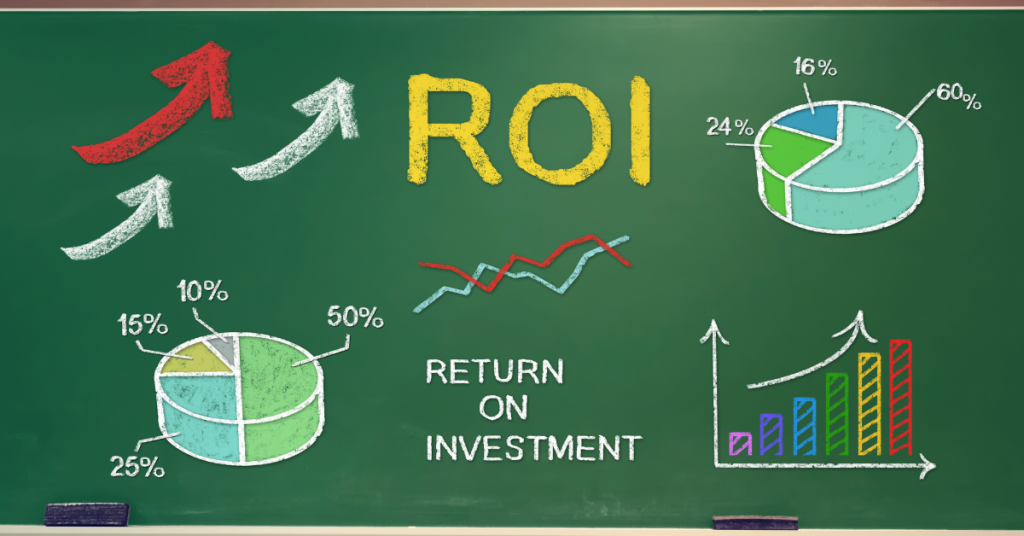
User Review
( votes)In the vibrant world of social media marketing, where every like, share and comment holds the potential to propel your business forward, understanding the return on investment (ROI) is not just beneficial—it’s essential.
Measuring the ROI of your social media efforts goes beyond mere number-crunching; it’s about deciphering the story behind each campaign, pinpointing what resonates with your audience, and, most importantly, ensuring that every dollar spent is an investment toward your business’s growth. But what exactly is ROI in the context of social media marketing? Simply put, it’s the measure of the profit or value generated from your social media activities compared to the investment you’ve made in them.
Let’s demystify ROI, arming you with simple yet effective tracking tips that promise to illuminate the path to success in the social media realm.
1. Defining Your Goals and Objectives
At the heart of any successful social media marketing strategy lies a clear set of goals and objectives. These aren’t just markers of what you hope to achieve; they are the very foundation upon which the success of your social media efforts is built and measured. Whether your aim is to elevate brand awareness, generate leads, or drive sales, setting precise, quantifiable goals is imperative.
Why Clear Goals Matter
Clear, measurable goals serve multiple crucial functions in social media marketing:
Direction: They provide a focused direction for your campaigns, ensuring every piece of content and every ad is aligned with what you want to achieve.
Measurement: They allow for the measurement of success. By defining what success looks like, you can accurately assess whether your efforts are paying off.
Optimization: They offer insights into what’s working and what isn’t, enabling you to fine-tune your strategy and optimize your campaigns for better results.
Tying Goals to ROI
Understanding the direct relationship between your social media goals and ROI is crucial. Here’s how specific objectives tie into calculating your ROI:
Increasing Brand Awareness: For goals centered around brand awareness, ROI can be measured through metrics like reach, impressions, and engagement rates. The higher these metrics, the more people are becoming aware of your brand, indicating a positive return on your investment in brand-focused campaigns.
Generating Leads: When the objective is lead generation, ROI is calculated by tracking the number of leads generated against the cost of the campaign. A successful lead generation campaign will see a higher number of qualified leads in relation to the investment made, demonstrating a clear return.
Boosting Sales: For sales-oriented goals, ROI becomes a matter of directly measuring the revenue generated from social media campaigns against the cost of running those campaigns. A positive ROI here means that the revenue attributable to social media efforts exceeds the cost, making your investment worthwhile.
In essence, defining your goals and objectives isn’t just a preliminary step; it’s a continuous process that shapes and refines your social media marketing strategy.

2. Understanding Key Metrics
To effectively measure the return on investment (ROI) of your social media marketing efforts, it’s crucial to understand and track specific key metrics. These metrics serve as indicators of your campaign’s performance, directly tying into the calculation of ROI. Let’s delve into these key metrics:
Reach: This measures the number of unique users who have seen your content. High reach indicates your content is spreading widely, potentially increasing brand awareness.
Engagement: This encompasses likes, comments, shares, and clicks. High engagement rates signify that your content resonates with your audience, fostering a sense of community and brand loyalty.
Leads Generated: The number of potential customers who have expressed interest in your product or service as a result of your campaign. Tracking leads is essential for campaigns aimed at filling the sales funnel.
Conversions: Conversions occur when a lead takes a desired action, such as signing up for a newsletter or making a purchase. This metric is a direct indicator of the effectiveness of your campaign in driving tangible results.
Sales: The ultimate goal for many campaigns, sales metrics track the actual revenue generated from social media efforts. This is critical for calculating the monetary return on your investment.
Tracking Metrics Using Social Media Analytics Tools
Each social media platform provides its own set of analytics tools designed to help you track these key metrics. To effectively track these metrics:
Regularly review the analytics dashboard on each platform to monitor campaign performance.
Set up conversion tracking where applicable to measure actions taken on your website as a result of social media campaigns.
Use UTM parameters for links shared on social media to track traffic and conversions from specific campaigns in Google Analytics.
Remember, the goal is not just to gather data but to analyze it in the context of your specific objectives and adjust your strategy accordingly.
3. Assigning Monetary Value to Your Goals
Understanding the monetary value of your social media marketing objectives is a crucial step in calculating ROI and ensuring your efforts yield tangible business benefits. Assigning a dollar value to actions such as leads generated or sales made helps quantify the impact of your campaigns. Here’s how you can approach this:
Assigning Value to Leads
To assign a value to a lead, consider the average conversion rate from lead to customer and the average transaction value. For example, if 1 out of every 10 leads becomes a customer and the average sale amount is $100, then each lead is worth $10 to your business.
Calculation:
Average Sale Amount: $100
Conversion Rate (Lead to Customer): 10%
Value of Each Lead = Average Sale Amount x Conversion Rate
Value of Each Lead = $100 x 10% = $10
Assigning Value to Sales
The value of a sale can be directly measured by the transaction amount. However, for businesses with multiple product lines or services, it’s beneficial to calculate an average sale amount. If your product A sells for $50 and product B sells for $150, and they sell in equal quantities, the average sale amount is $100.
Calculation:
Product A Price: $50
Product B Price: $150
Average Sale Amount = (Product A Price + Product B Price) / Number of Products
Average Sale Amount = ($50 + $150) / 2 = $100
Assigning Value to Brand Awareness and Engagement
Valuing less tangible objectives like brand awareness and engagement can be more complex. One approach is to calculate the cost of achieving similar reach through paid advertising. For instance, if 1000 impressions on social media would cost $5 on average through paid ads, and your post received 2000 organic impressions, you could assign a $10 value to that post’s reach.
Calculation:
Cost Per 1000 Impressions (CPM) in Paid Advertising: $5
Organic Impressions Achieved: 2000
Value of Organic Impressions = (Organic Impressions / 1000) x CPM
Value of Organic Impressions = (2000 / 1000) x $5 = $10
Tracking and Utilizing Data
To effectively assign monetary values, it’s important to:
Collect and Analyze Historical Data: Look at past sales data, conversion rates, and engagement metrics to establish benchmarks.
Use CRM and Analytics Tools: Leverage tools that track customer interactions from first contact through to sale, helping you understand the path and value of conversions.
Adjust Values Over Time: As your business grows and market conditions change, revisit and adjust these values to reflect current realities.
Assigning monetary values to your social media objectives transforms abstract metrics into concrete business outcomes. It allows you to make informed decisions about where to allocate resources and how to maximize the return on your social media investments.

4. Calculating Costs
A critical aspect of measuring the ROI of your social media marketing efforts is accurately calculating all associated costs. Understanding the full scope of your investment allows you to assess the true value that social media brings to your business. Here’s a breakdown of the various costs involved and the importance of meticulous record-keeping.
Ad Spend
This is the most direct cost and includes all money spent on paid social media advertisements. Whether you’re using pay-per-click (PPC) models, sponsored content, or display ads across platforms like Facebook, Instagram, or LinkedIn, each dollar spent counts toward your total investment.
Content Creation
High-quality content is the backbone of effective social media marketing. This category encompasses expenses related to producing engaging content, including graphic design, video production, copywriting, and photography. Whether you’re creating in-house or outsourcing, every aspect of content creation incurs costs.
Management Tools
Social media management tools streamline posting, scheduling, analytics, and engagement across multiple platforms. Subscriptions to tools like Hootsuite, Buffer, or Sprout Social are investments aimed at enhancing efficiency and insights but are also costs that need to be factored into your overall budget.
Labor Costs
The time and effort put into managing your social media campaigns have a monetary value. This includes the salaries or fees for social media managers, consultants, or agencies that oversee your strategy, content creation, posting, and community engagement.
Training and Development
Staying competitive in social media marketing often requires ongoing training and development for you or your team. Costs for webinars, courses, certifications, and conferences designed to enhance skills and knowledge in social media strategies should also be considered.
Software and Subscriptions
Beyond management tools, other software subscriptions might be necessary for content creation, such as Adobe Creative Suite, Canva Pro, or video editing tools. These subscriptions contribute to the overall cost of your social media marketing efforts.
The Importance of Accurate Record-Keeping
Keeping precise records of these expenses is vital for several reasons:
Accurate ROI Calculation: To calculate ROI, you need to know exactly how much you’re investing. Underestimating or overlooking costs can lead to an inaccurate assessment of your social media marketing’s effectiveness.
Budget Management: Detailed records help you stay within your budget and identify areas where you may be overspending or could allocate resources more efficiently.
Strategic Decision Making: Understanding where your money is going enables you to make informed decisions about future investments in your social media strategy.
This disciplined approach to financial tracking is a cornerstone of successful marketing strategy and business growth.
5. Calculating Your Social Media ROI
Calculating the return on investment (ROI) for your social media marketing efforts is crucial for understanding the efficiency and effectiveness of your campaigns. The basic formula for calculating ROI is:

This formula helps quantify the profitability of your social media activities, allowing you to make informed decisions about future marketing strategies. Let’s walk through a couple of examples to illustrate how to calculate ROI for a social media campaign.
Example 1: Generating Leads
Goal: Generate leads for a new service
Metrics:
50 leads generated
Value per lead: $50 (based on the potential revenue each lead represents)
Costs:
Ad spend: $500
Content creation: $200
Management tools: $100
Total Investment: $800
Return:
Total value of leads: 50 leads * $50 = $2500

Example 2: Boosting Sales
Goal: Increase sales of a product
Metrics:
100 products sold via social media campaign
Average sale amount: $30
Costs:
Ad spend: $1000
Content creation: $300
Labor: $200
Total Investment: $1500
Return:
Total sales: 100 * $30 = $3000

6. Utilizing Tracking Tools and Software
In the realm of social media marketing, accurately tracking and calculating ROI can be streamlined significantly with the right tools and software. These solutions automate data collection and analysis, providing insights that are crucial for optimizing your campaigns. Here’s a selection of recommended tools and software, along with their benefits for ROI analysis:
Google Analytics
Features: Google Analytics is a comprehensive web analytics service that tracks and reports website traffic. It can be integrated with social media platforms to track conversions, page views, and user behavior originating from social media referrals.
Benefits: It allows marketers to see the direct impact of social media on website traffic and conversions, making it easier to calculate ROI. Custom goals and conversion funnels can be set up to track specific actions taken by visitors from social media.
Social Media Analytics Tools
Platforms like Facebook Insights, Twitter Analytics, and LinkedIn Analytics provide in-depth data on campaign performance, including reach, engagement, and conversion metrics specific to their platforms.
Benefits: These native tools offer insights into the effectiveness of your content and ads on each platform, enabling targeted adjustments to improve ROI. They also help identify which content resonates most with your audience.
CRM Software
Examples: Salesforce, HubSpot, and Zoho CRM
Features: CRM software helps manage customer interactions, track sales, and marketing activities, and automate communications. Many CRMs can be integrated with social media platforms to track leads and conversions originating from social campaigns.
Benefits: CRM integration offers a holistic view of the customer journey, from initial social media engagement to final conversion. This insight is invaluable for attributing sales to specific campaigns and calculating social media ROI.
Social Media Management Tools
Examples: Hootsuite, Buffer, and Sprout Social
Features: These tools offer scheduling, posting, and analytics across multiple social media accounts from a single dashboard. Advanced analytics features provide data on campaign performance, audience demographics, and engagement trends.
Benefits: Management tools save time and provide actionable insights to improve content strategy and campaign performance, directly impacting ROI. They also allow for the monitoring of multiple channels simultaneously, offering a comprehensive view of your social media efforts.
Advertising Platforms
Examples: Google Ads, Facebook Ads Manager
Features: Advertising platforms come with built-in analytics to track the performance of paid campaigns, including impressions, clicks, conversions, and more.
Benefits: Direct integration with analytics allows for precise tracking of campaign ROI, enabling marketers to adjust bidding strategies and ad placements for optimal performance.
Conclusion
In the dynamic world of social media marketing, accurately tracking ROI is essential for steering strategies toward success. It empowers businesses to make data-driven decisions, ensuring resources are allocated effectively and marketing efforts yield tangible results. By embracing the outlined tracking tips, businesses can refine their social media campaigns, optimize engagement, and elevate their overall marketing performance. Let these insights guide you to not only measure but amplify the impact of your social media endeavors, turning insights into action and investments into growth.







